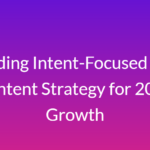The Evolution of Intent-Driven B2B Content
As B2B buyers become more informed and self-reliant, traditional lead generation tactics lose their impact. Buyers expect tailored, timely content that matches their intent and decision-making pace. A modern B2B Content Strategy must shift from mass appeal to hyper-relevance—crafting narratives that resonate with specific pain points, job functions, and buying stages. This evolution means marketers need to rethink not just what content they create, but why and when they deliver it.
Identifying Buyer Intent with Actionable Insights
Intent signals can be as subtle as multiple visits to a pricing page or as direct as downloading a competitor comparison guide. These behavioral cues provide real-time feedback on where a prospect stands in their buying journey. A well-informed B2B Content Strategy leverages this insight to align content assets with the buyer’s immediate needs. Instead of nurturing leads through arbitrary sequences, the strategy becomes responsive—delivering the right message based on the latest interaction.
Building a Funnel That Responds to Buyer Movement
The modern B2B funnel is not linear. Buyers jump between stages, revisit earlier research, and involve multiple stakeholders before making a decision. An agile B2B Content Strategy is designed to accommodate this non-linear path. It delivers modular, intent-specific content at each touchpoint. Educational blogs draw in awareness, downloadable guides support evaluation, and case studies with measurable ROI speak to late-stage decision-makers—all guided by observed buyer behavior.
Strategizing Content by Role, Vertical, and Account Type
Effective messaging varies depending on the role of the decision-maker and the vertical they belong to. A marketing leader and an IT director will consume and prioritize different types of content, even when exploring the same solution. A comprehensive B2B Content Strategy addresses these nuances by creating role-based and industry-specific content variations. With account type segmentation—SMBs, mid-market, or enterprise—content can be further customized for challenges, budget ranges, and buying timelines.
Repurposing with Purpose: From Single Assets to Campaign Engines
Creating high-performing content doesn’t always require starting from scratch. A smart B2B Content Strategy includes built-in repurposing workflows. A whitepaper can become multiple blog posts, an infographic, a podcast episode, and a webinar series. This maximizes reach while reinforcing core messaging across channels. Each repurposed asset can be tailored for a specific stage or intent level, extending shelf life and audience engagement without extra content production strain.
Channel-Specific Delivery for Intent Optimization
Not all platforms are equal when it comes to buyer intent. Google Search reveals high-intent queries, LinkedIn drives interest-stage discovery, while email is ideal for nurturing known leads. A responsive B2B Content Strategy takes these differences into account. It maps each content type to the most effective channel. For example, use product comparisons in Google Ads, thought leadership on LinkedIn, and gated assets in email nurtures. This approach ensures content meets buyers where they are and speaks their language.
AI-Enhanced Content Recommendations Based on Intent
AI-powered martech tools can analyze patterns in buyer behavior and recommend content dynamically. These tools evaluate past actions, content consumption paths, and demographic data to determine what piece should come next. When incorporated into a B2B Content Strategy, this automation enables marketers to build personalized journeys without manual effort. AI-generated recommendations increase engagement by delivering content that feels timely, curated, and relevant.
Aligning Marketing and Sales with Shared Content Objectives
Sales and marketing misalignment leads to content disconnects and missed revenue opportunities. A high-performing B2B Content Strategy includes joint content planning sessions where both teams collaborate on messaging, timing, and asset selection. This alignment ensures that every piece of content not only supports top-of-funnel awareness but also reinforces sales conversations and closes deals faster. Sales can feed marketing real objections and FAQs to inspire new content creation.
Refreshing and Recycling Evergreen Content for Sustained Growth
Content aging is inevitable, but a good B2B Content Strategy plans for long-term value by identifying which assets can be refreshed instead of replaced. Evergreen pieces like “Ultimate Guides” or “Top Trends” can be updated annually with new data, visuals, and examples. By refreshing instead of recreating, marketers retain search equity while keeping their message relevant. Recycling content keeps libraries fresh without exhausting internal content teams.
Driving ROI Through Performance-Based Strategy Adjustments
Great strategies are built on feedback. The most effective B2B Content Strategy is not static—it evolves based on performance. Regular review of KPIs like bounce rate, form fills, scroll depth, and content attribution gives marketers a data-backed understanding of what works and what needs optimization. Adjusting CTAs, refining tone, or swapping content types based on these metrics ensures continuous improvement and stronger pipeline contribution over time.
Read the Full Blog Now @ https://acceligize.com/featured-blogs/smart-b2b-content-strategy-aligned-with-buyer-intent/
About Us
Acceligize empowers modern marketers with cutting-edge AI solutions designed to transform lead generation. From real-time predictive scoring to intelligent segmentation, our platform enables B2B brands to drive revenue with precision and confidence. By leveraging the power of automation and machine learning, Acceligize helps businesses stay ahead of the curve in lead scoring & segmentation in 2025 and beyond.

